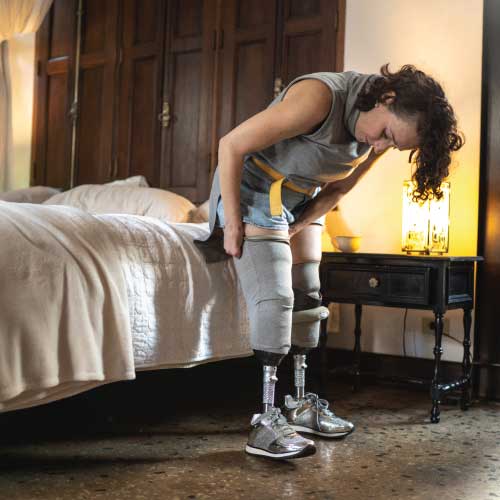A Design Guide for DIY Prostheses
Desiree Riny, a graduate of the Royal Melbourne Institute of Technology (RMIT), created a design guide that could benefit individuals with limb loss who don't have access to healthcare. Instead, they can use accessible materials, such as bicycle parts and other scrap materials, to create their own lower-limb prosthetic device.

The guide is a part of Riny's industrial design master's thesis project at RMIT titled "Reclaiming Accessibility: To Lower Limb Prosthetics." She created the manual after a year spent investigating the realities of rural dwellers in developing countries and how individuals with limb loss manage their lower-limb amputations. Her study included rural areas in Cambodia, Cameroon, India, South Sudan, and Sudan.
“The latest advances in prosthetic technology mean nothing to most of the world’s amputees, who either live too far from healthcare services or can’t afford it.”
According to Riny in an interview for Dezeen, the latest advances in prosthetic technology mean nothing to most of the world's amputees, who either live too far from healthcare services or can't afford it. Her investigation also found that 95% of lower-limb amputees worldwide live in such conditions, making access to medical care almost impossible.
Riny's project addresses the issue of affordability and accessibility, as well as the fact that most prosthetic devices are unsuitable for rural environments, making them difficult to maintain.
“3D printing is cost-effective but difficult to repair, especially in rural areas in developing countries.”
Some advanced technologies that may make prosthetics more accessible may not be suitable in a rural environment. An example is 3D printing, which is cost-effective but often difficult to repair, especially in rural settings. Such limitations can be overcome by finding DIY solutions tailored to local materials and traditional practices.
As part of her investigation, Riny looked to the solutions that people in these communities were already using then applied current medical best practices. This is why her designs use bicycle parts, scrap wood and metal, old clothes, and rice sacks—materials used in rural communities.
Besides the design manual, which Riny hopes will be available online and distributed through non-government organizations and local businesses, the project also includes three DIY prosthetic legs that suit different needs.
One prosthesis offers a high degree of stability but barely moves at the foot joint. Meanwhile, the other two prosthetic legs provide more than 30 degrees of movement, using a bike seat rail to mimic joints.
When asked about her choice of using bicycle parts, Riny said that in many countries she investigated, bicycles are a vital mode of transportation, and locals are familiar with taking them apart.
Besides bicycle seat rails, Riny also recommends using high-tensile fibers from everyday objects, such as the hemp from rice sacks, as prosthetic sockets. She reinforced these fibers with synthetic fibers from old clothing and resin. This process is adaptable to many kinds of materials, depending on what is locally available.
By using high-tensile fibers, users can repair and adjust their DIY prosthetic legs without requiring medical experts to adjust a single screw or deliveries for certain parts.
Although Riny could not visit the places included in her thesis, she had turned her vision into a start-up. They are currently raising funds for travel so that the next stage of the process can involve co-designing with remote communities. Riny's start-up is being supported by RMIT's incubator called Activator.










































































